Financial and Accounting Management
VerifiedAdded on 2023/06/03
|22
|3422
|145
AI Summary
This article discusses financial and accounting management techniques such as payback period, accounting rate of return, net present value, and internal rate of return. It analyzes the financial performance of two projects and makes a decision based on the results. The article also includes a case study on the food and beverage division of a hotel.
Contribute Materials
Your contribution can guide someone’s learning journey. Share your
documents today.
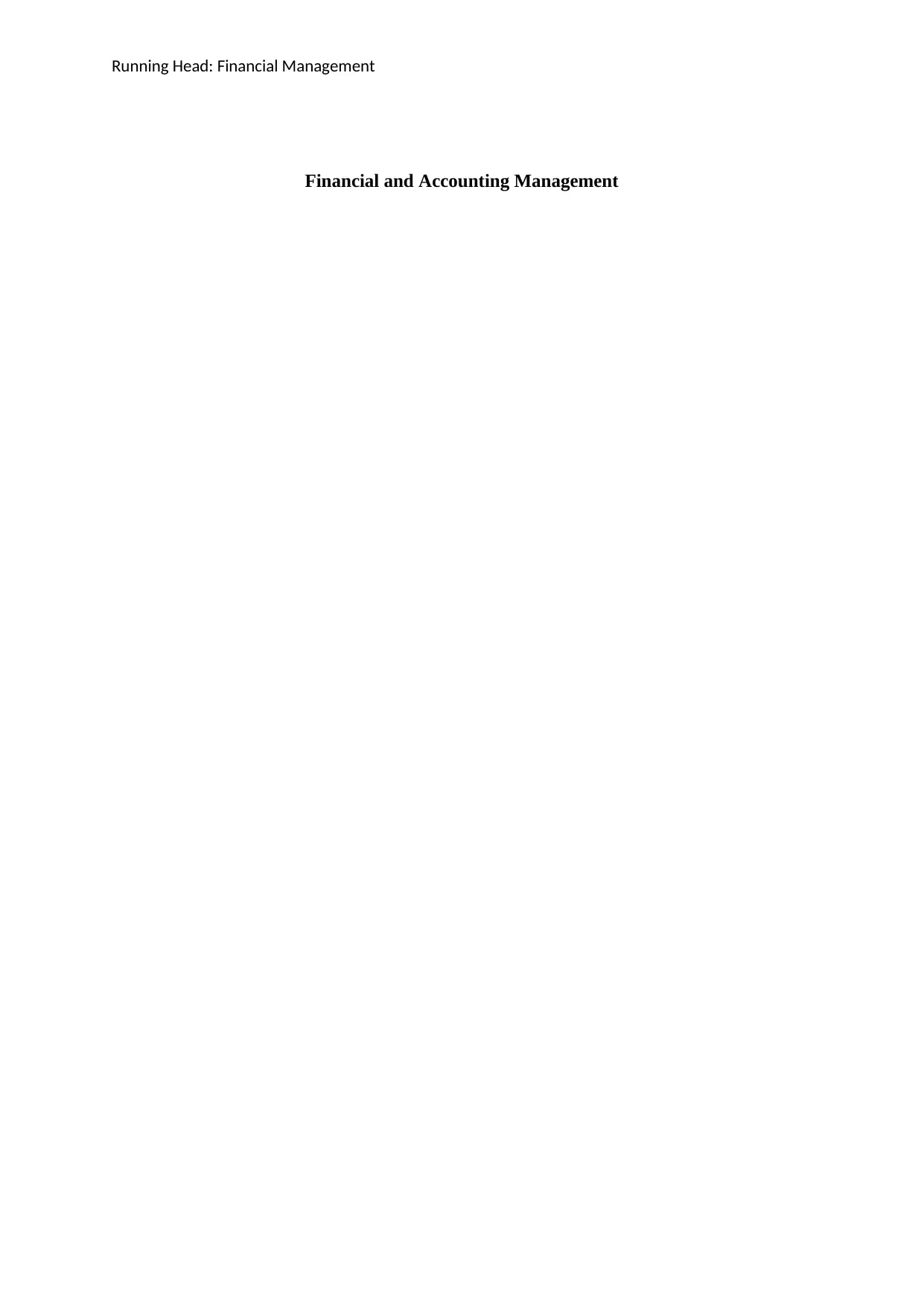
Running Head: Financial Management
Financial and Accounting Management
Financial and Accounting Management
Secure Best Marks with AI Grader
Need help grading? Try our AI Grader for instant feedback on your assignments.
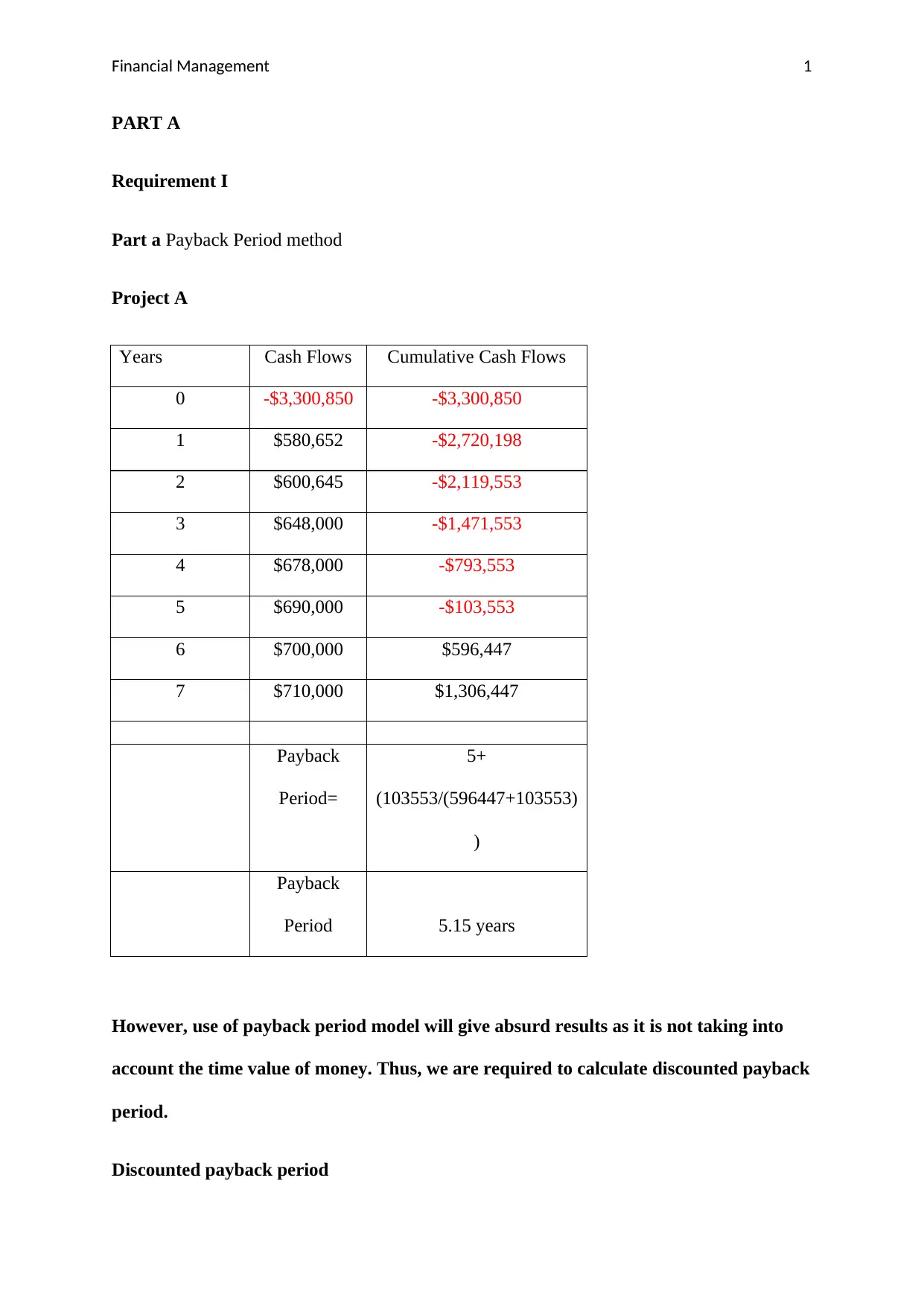
Financial Management 1
PART A
Requirement I
Part a Payback Period method
Project A
Years Cash Flows Cumulative Cash Flows
0 -$3,300,850 -$3,300,850
1 $580,652 -$2,720,198
2 $600,645 -$2,119,553
3 $648,000 -$1,471,553
4 $678,000 -$793,553
5 $690,000 -$103,553
6 $700,000 $596,447
7 $710,000 $1,306,447
Payback
Period=
5+
(103553/(596447+103553)
)
Payback
Period 5.15 years
However, use of payback period model will give absurd results as it is not taking into
account the time value of money. Thus, we are required to calculate discounted payback
period.
Discounted payback period
PART A
Requirement I
Part a Payback Period method
Project A
Years Cash Flows Cumulative Cash Flows
0 -$3,300,850 -$3,300,850
1 $580,652 -$2,720,198
2 $600,645 -$2,119,553
3 $648,000 -$1,471,553
4 $678,000 -$793,553
5 $690,000 -$103,553
6 $700,000 $596,447
7 $710,000 $1,306,447
Payback
Period=
5+
(103553/(596447+103553)
)
Payback
Period 5.15 years
However, use of payback period model will give absurd results as it is not taking into
account the time value of money. Thus, we are required to calculate discounted payback
period.
Discounted payback period
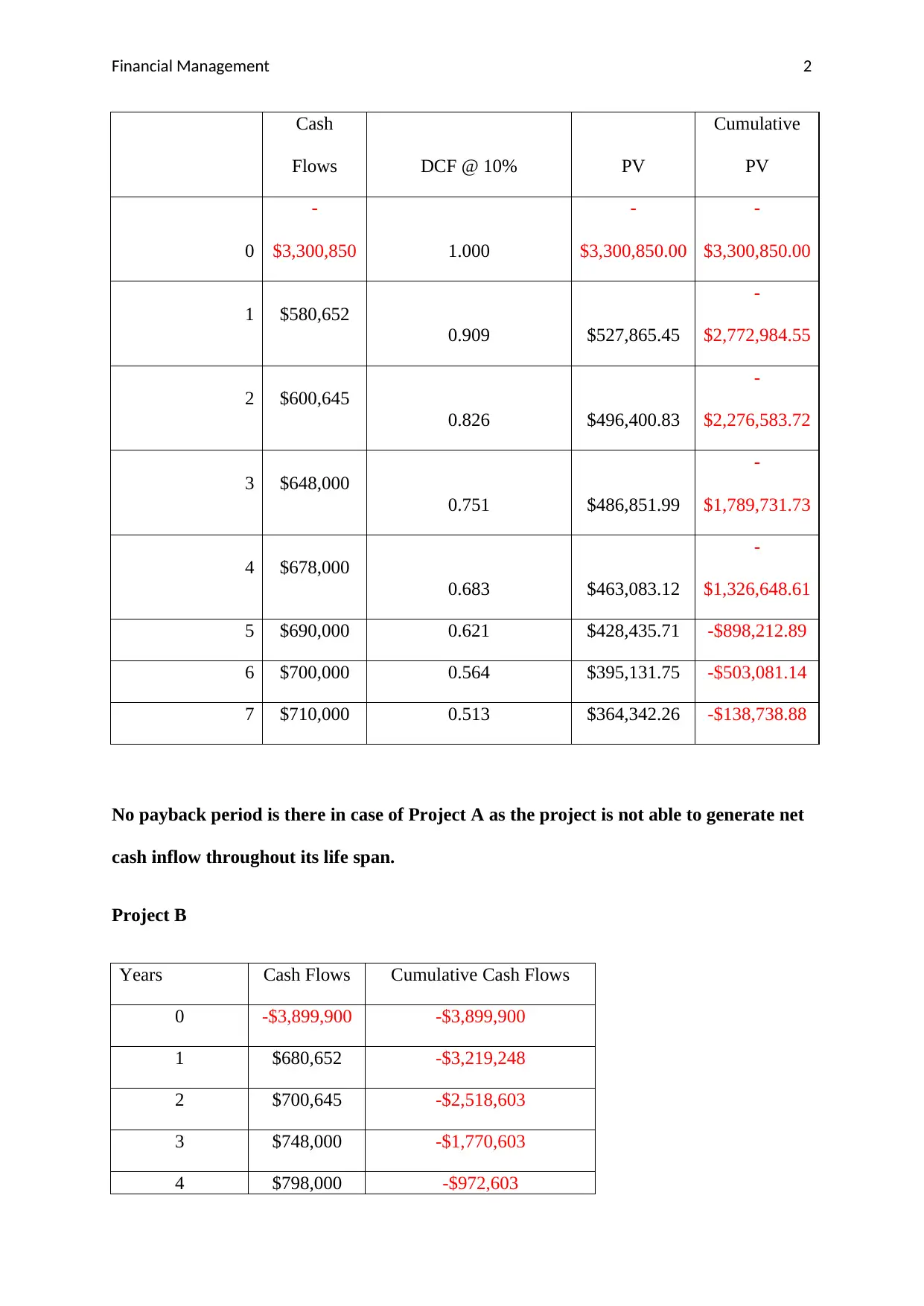
Financial Management 2
Cash
Flows DCF @ 10% PV
Cumulative
PV
0
-
$3,300,850 1.000
-
$3,300,850.00
-
$3,300,850.00
1 $580,652
0.909 $527,865.45
-
$2,772,984.55
2 $600,645
0.826 $496,400.83
-
$2,276,583.72
3 $648,000
0.751 $486,851.99
-
$1,789,731.73
4 $678,000
0.683 $463,083.12
-
$1,326,648.61
5 $690,000 0.621 $428,435.71 -$898,212.89
6 $700,000 0.564 $395,131.75 -$503,081.14
7 $710,000 0.513 $364,342.26 -$138,738.88
No payback period is there in case of Project A as the project is not able to generate net
cash inflow throughout its life span.
Project B
Years Cash Flows Cumulative Cash Flows
0 -$3,899,900 -$3,899,900
1 $680,652 -$3,219,248
2 $700,645 -$2,518,603
3 $748,000 -$1,770,603
4 $798,000 -$972,603
Cash
Flows DCF @ 10% PV
Cumulative
PV
0
-
$3,300,850 1.000
-
$3,300,850.00
-
$3,300,850.00
1 $580,652
0.909 $527,865.45
-
$2,772,984.55
2 $600,645
0.826 $496,400.83
-
$2,276,583.72
3 $648,000
0.751 $486,851.99
-
$1,789,731.73
4 $678,000
0.683 $463,083.12
-
$1,326,648.61
5 $690,000 0.621 $428,435.71 -$898,212.89
6 $700,000 0.564 $395,131.75 -$503,081.14
7 $710,000 0.513 $364,342.26 -$138,738.88
No payback period is there in case of Project A as the project is not able to generate net
cash inflow throughout its life span.
Project B
Years Cash Flows Cumulative Cash Flows
0 -$3,899,900 -$3,899,900
1 $680,652 -$3,219,248
2 $700,645 -$2,518,603
3 $748,000 -$1,770,603
4 $798,000 -$972,603
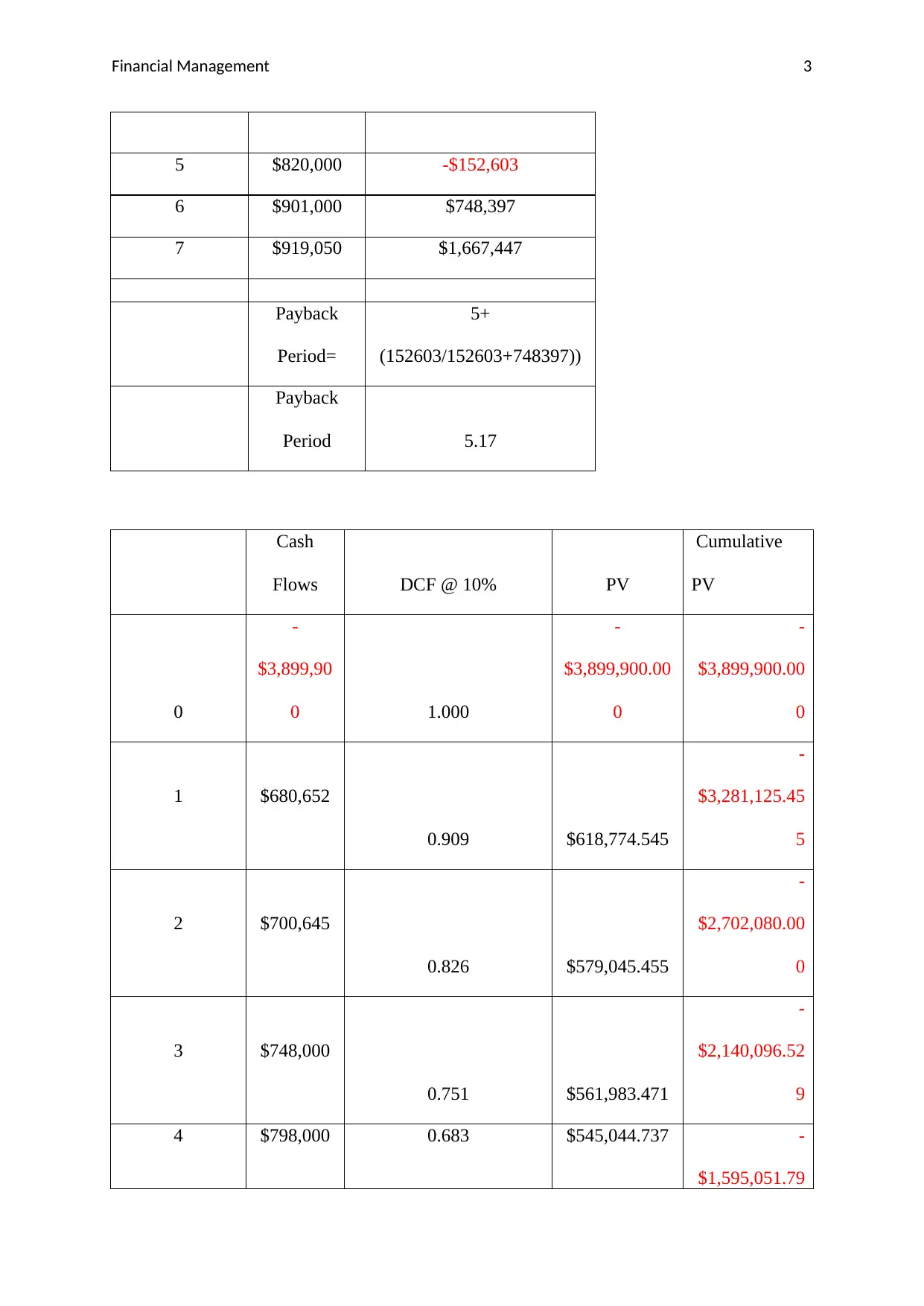
Financial Management 3
5 $820,000 -$152,603
6 $901,000 $748,397
7 $919,050 $1,667,447
Payback
Period=
5+
(152603/152603+748397))
Payback
Period 5.17
Cash
Flows DCF @ 10% PV
Cumulative
PV
0
-
$3,899,90
0 1.000
-
$3,899,900.00
0
-
$3,899,900.00
0
1 $680,652
0.909 $618,774.545
-
$3,281,125.45
5
2 $700,645
0.826 $579,045.455
-
$2,702,080.00
0
3 $748,000
0.751 $561,983.471
-
$2,140,096.52
9
4 $798,000 0.683 $545,044.737 -
$1,595,051.79
5 $820,000 -$152,603
6 $901,000 $748,397
7 $919,050 $1,667,447
Payback
Period=
5+
(152603/152603+748397))
Payback
Period 5.17
Cash
Flows DCF @ 10% PV
Cumulative
PV
0
-
$3,899,90
0 1.000
-
$3,899,900.00
0
-
$3,899,900.00
0
1 $680,652
0.909 $618,774.545
-
$3,281,125.45
5
2 $700,645
0.826 $579,045.455
-
$2,702,080.00
0
3 $748,000
0.751 $561,983.471
-
$2,140,096.52
9
4 $798,000 0.683 $545,044.737 -
$1,595,051.79
Secure Best Marks with AI Grader
Need help grading? Try our AI Grader for instant feedback on your assignments.

Financial Management 4
2
5 $820,000
0.621 $509,155.485
-
$1,085,896.30
7
6 $901,000 0.564 $508,591.011 -$577,305.296
7 $919,050 0.513 $471,617.969 -$105,687.327
Under both the project alternatives the cost of initial investment will be recovered in 5 years
and few months as per simple payback model. However, Project B will take few months
more than Project A.
But as per discounted payback period model, there will no payback period in both the cases.
Part b: Accounting Rate of Return (ARR)
It is assumed that accounting profits and cash flows are equivalent to each other as no
information of accounting profits is given in case.
Project A
Years Cash Flows
0 -$3,300,850
1 $580,652
2 $600,645
3 $648,000
4 $678,000
2
5 $820,000
0.621 $509,155.485
-
$1,085,896.30
7
6 $901,000 0.564 $508,591.011 -$577,305.296
7 $919,050 0.513 $471,617.969 -$105,687.327
Under both the project alternatives the cost of initial investment will be recovered in 5 years
and few months as per simple payback model. However, Project B will take few months
more than Project A.
But as per discounted payback period model, there will no payback period in both the cases.
Part b: Accounting Rate of Return (ARR)
It is assumed that accounting profits and cash flows are equivalent to each other as no
information of accounting profits is given in case.
Project A
Years Cash Flows
0 -$3,300,850
1 $580,652
2 $600,645
3 $648,000
4 $678,000
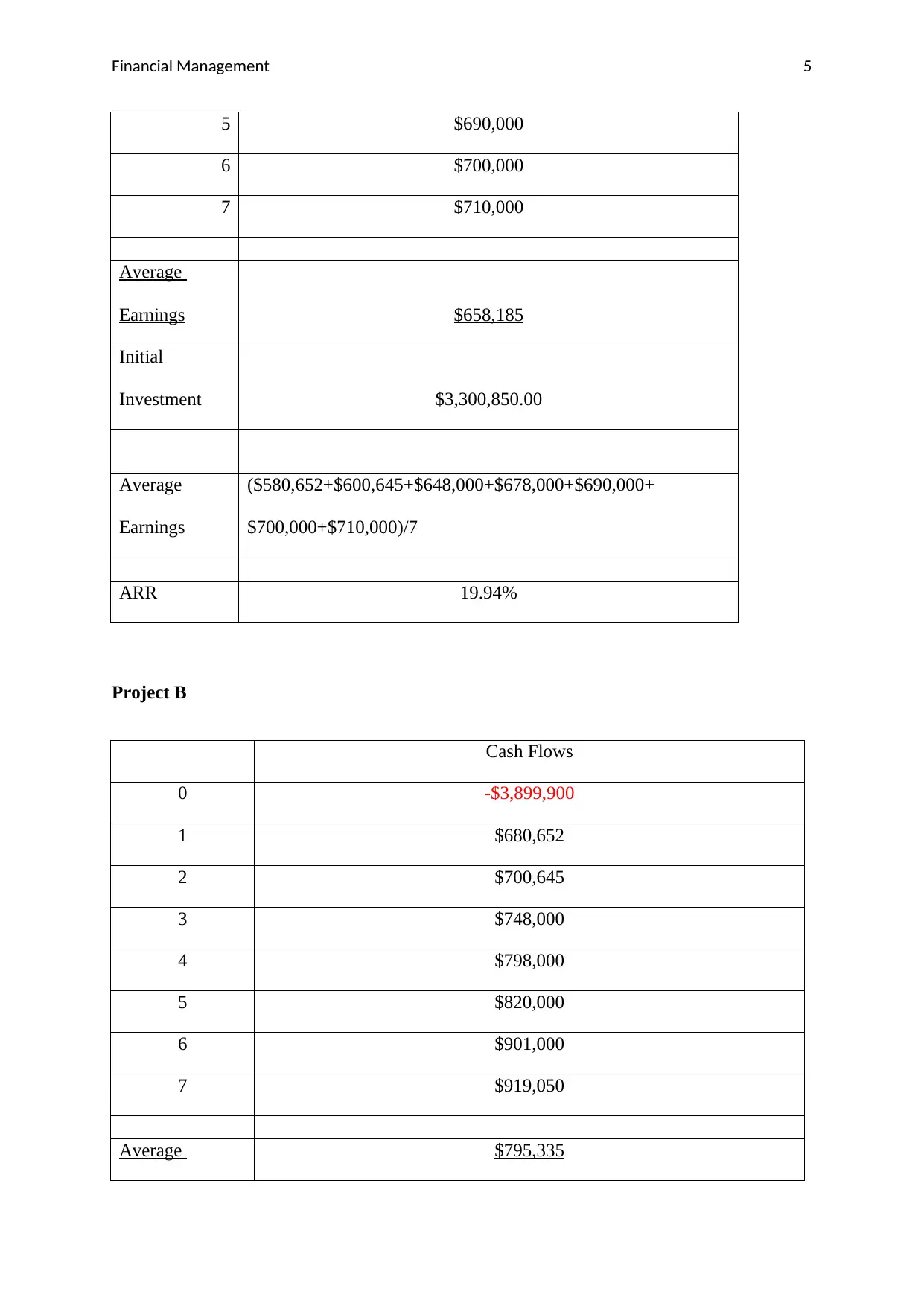
Financial Management 5
5 $690,000
6 $700,000
7 $710,000
Average
Earnings $658,185
Initial
Investment $3,300,850.00
Average
Earnings
($580,652+$600,645+$648,000+$678,000+$690,000+
$700,000+$710,000)/7
ARR 19.94%
Project B
Cash Flows
0 -$3,899,900
1 $680,652
2 $700,645
3 $748,000
4 $798,000
5 $820,000
6 $901,000
7 $919,050
Average $795,335
5 $690,000
6 $700,000
7 $710,000
Average
Earnings $658,185
Initial
Investment $3,300,850.00
Average
Earnings
($580,652+$600,645+$648,000+$678,000+$690,000+
$700,000+$710,000)/7
ARR 19.94%
Project B
Cash Flows
0 -$3,899,900
1 $680,652
2 $700,645
3 $748,000
4 $798,000
5 $820,000
6 $901,000
7 $919,050
Average $795,335
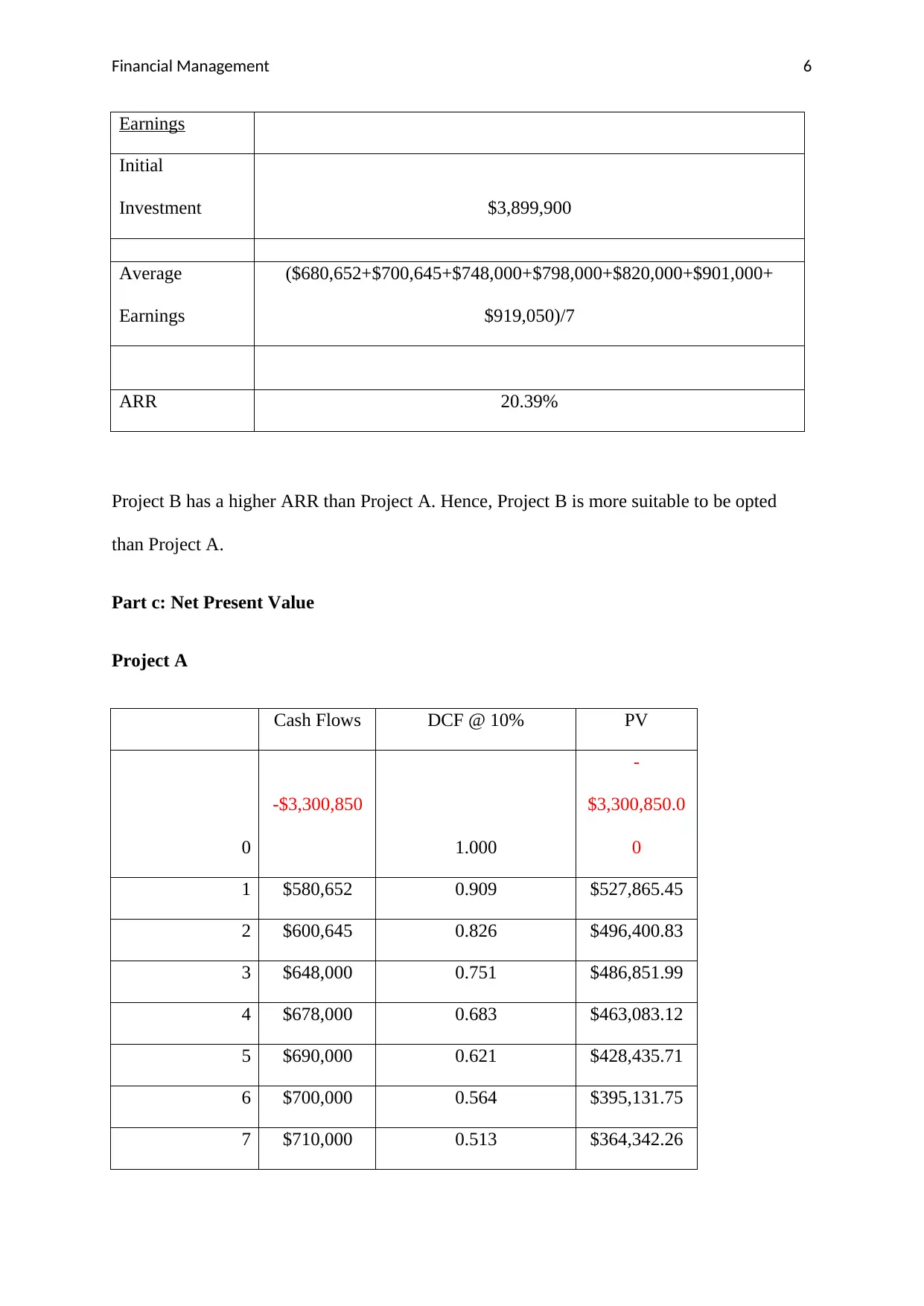
Financial Management 6
Earnings
Initial
Investment $3,899,900
Average
Earnings
($680,652+$700,645+$748,000+$798,000+$820,000+$901,000+
$919,050)/7
ARR 20.39%
Project B has a higher ARR than Project A. Hence, Project B is more suitable to be opted
than Project A.
Part c: Net Present Value
Project A
Cash Flows DCF @ 10% PV
0
-$3,300,850
1.000
-
$3,300,850.0
0
1 $580,652 0.909 $527,865.45
2 $600,645 0.826 $496,400.83
3 $648,000 0.751 $486,851.99
4 $678,000 0.683 $463,083.12
5 $690,000 0.621 $428,435.71
6 $700,000 0.564 $395,131.75
7 $710,000 0.513 $364,342.26
Earnings
Initial
Investment $3,899,900
Average
Earnings
($680,652+$700,645+$748,000+$798,000+$820,000+$901,000+
$919,050)/7
ARR 20.39%
Project B has a higher ARR than Project A. Hence, Project B is more suitable to be opted
than Project A.
Part c: Net Present Value
Project A
Cash Flows DCF @ 10% PV
0
-$3,300,850
1.000
-
$3,300,850.0
0
1 $580,652 0.909 $527,865.45
2 $600,645 0.826 $496,400.83
3 $648,000 0.751 $486,851.99
4 $678,000 0.683 $463,083.12
5 $690,000 0.621 $428,435.71
6 $700,000 0.564 $395,131.75
7 $710,000 0.513 $364,342.26
Paraphrase This Document
Need a fresh take? Get an instant paraphrase of this document with our AI Paraphraser
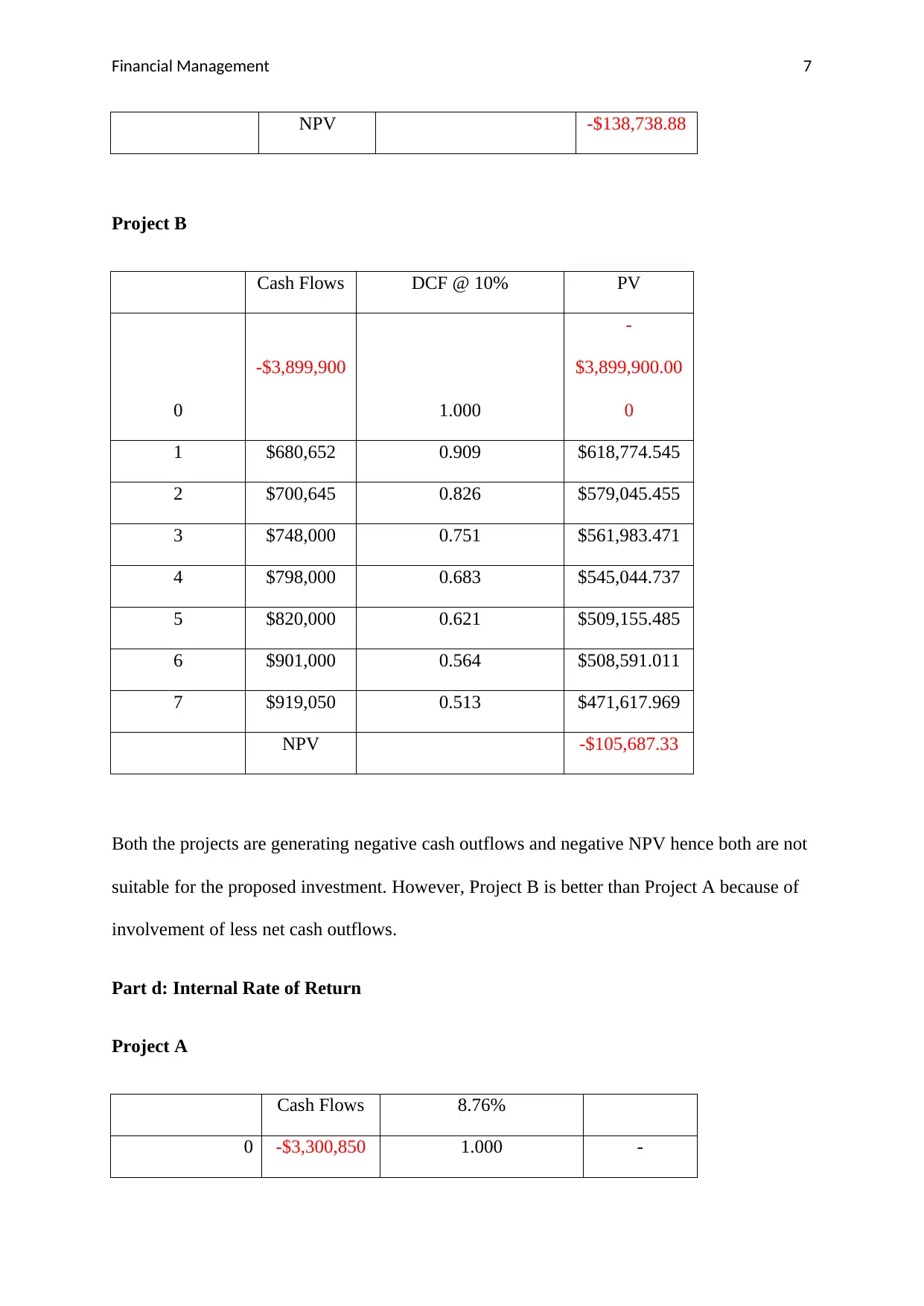
Financial Management 7
NPV -$138,738.88
Project B
Cash Flows DCF @ 10% PV
0
-$3,899,900
1.000
-
$3,899,900.00
0
1 $680,652 0.909 $618,774.545
2 $700,645 0.826 $579,045.455
3 $748,000 0.751 $561,983.471
4 $798,000 0.683 $545,044.737
5 $820,000 0.621 $509,155.485
6 $901,000 0.564 $508,591.011
7 $919,050 0.513 $471,617.969
NPV -$105,687.33
Both the projects are generating negative cash outflows and negative NPV hence both are not
suitable for the proposed investment. However, Project B is better than Project A because of
involvement of less net cash outflows.
Part d: Internal Rate of Return
Project A
Cash Flows 8.76%
0 -$3,300,850 1.000 -
NPV -$138,738.88
Project B
Cash Flows DCF @ 10% PV
0
-$3,899,900
1.000
-
$3,899,900.00
0
1 $680,652 0.909 $618,774.545
2 $700,645 0.826 $579,045.455
3 $748,000 0.751 $561,983.471
4 $798,000 0.683 $545,044.737
5 $820,000 0.621 $509,155.485
6 $901,000 0.564 $508,591.011
7 $919,050 0.513 $471,617.969
NPV -$105,687.33
Both the projects are generating negative cash outflows and negative NPV hence both are not
suitable for the proposed investment. However, Project B is better than Project A because of
involvement of less net cash outflows.
Part d: Internal Rate of Return
Project A
Cash Flows 8.76%
0 -$3,300,850 1.000 -
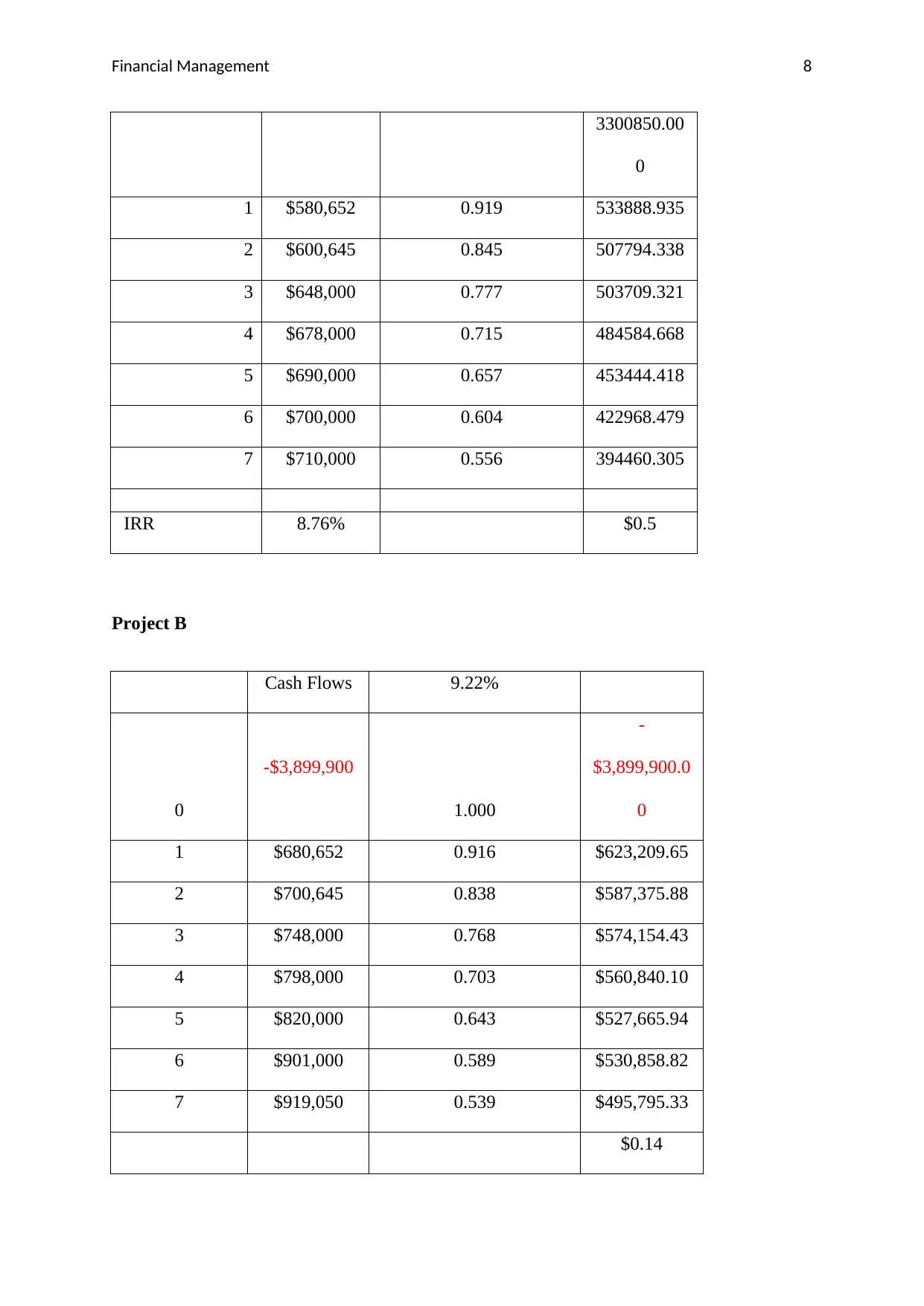
Financial Management 8
3300850.00
0
1 $580,652 0.919 533888.935
2 $600,645 0.845 507794.338
3 $648,000 0.777 503709.321
4 $678,000 0.715 484584.668
5 $690,000 0.657 453444.418
6 $700,000 0.604 422968.479
7 $710,000 0.556 394460.305
IRR 8.76% $0.5
Project B
Cash Flows 9.22%
0
-$3,899,900
1.000
-
$3,899,900.0
0
1 $680,652 0.916 $623,209.65
2 $700,645 0.838 $587,375.88
3 $748,000 0.768 $574,154.43
4 $798,000 0.703 $560,840.10
5 $820,000 0.643 $527,665.94
6 $901,000 0.589 $530,858.82
7 $919,050 0.539 $495,795.33
$0.14
3300850.00
0
1 $580,652 0.919 533888.935
2 $600,645 0.845 507794.338
3 $648,000 0.777 503709.321
4 $678,000 0.715 484584.668
5 $690,000 0.657 453444.418
6 $700,000 0.604 422968.479
7 $710,000 0.556 394460.305
IRR 8.76% $0.5
Project B
Cash Flows 9.22%
0
-$3,899,900
1.000
-
$3,899,900.0
0
1 $680,652 0.916 $623,209.65
2 $700,645 0.838 $587,375.88
3 $748,000 0.768 $574,154.43
4 $798,000 0.703 $560,840.10
5 $820,000 0.643 $527,665.94
6 $901,000 0.589 $530,858.82
7 $919,050 0.539 $495,795.33
$0.14
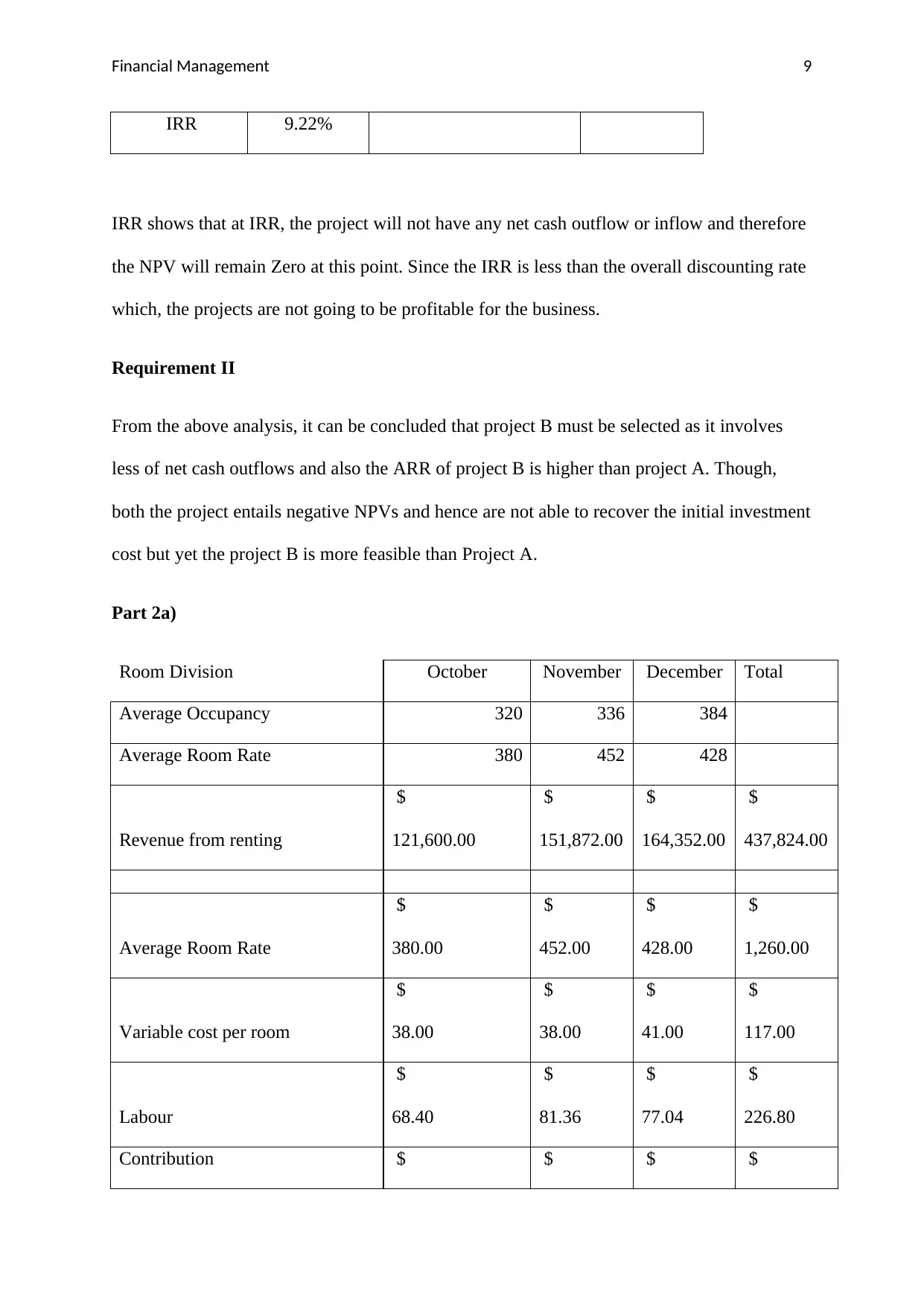
Financial Management 9
IRR 9.22%
IRR shows that at IRR, the project will not have any net cash outflow or inflow and therefore
the NPV will remain Zero at this point. Since the IRR is less than the overall discounting rate
which, the projects are not going to be profitable for the business.
Requirement II
From the above analysis, it can be concluded that project B must be selected as it involves
less of net cash outflows and also the ARR of project B is higher than project A. Though,
both the project entails negative NPVs and hence are not able to recover the initial investment
cost but yet the project B is more feasible than Project A.
Part 2a)
Room Division October November December Total
Average Occupancy 320 336 384
Average Room Rate 380 452 428
Revenue from renting
$
121,600.00
$
151,872.00
$
164,352.00
$
437,824.00
Average Room Rate
$
380.00
$
452.00
$
428.00
$
1,260.00
Variable cost per room
$
38.00
$
38.00
$
41.00
$
117.00
Labour
$
68.40
$
81.36
$
77.04
$
226.80
Contribution $ $ $ $
IRR 9.22%
IRR shows that at IRR, the project will not have any net cash outflow or inflow and therefore
the NPV will remain Zero at this point. Since the IRR is less than the overall discounting rate
which, the projects are not going to be profitable for the business.
Requirement II
From the above analysis, it can be concluded that project B must be selected as it involves
less of net cash outflows and also the ARR of project B is higher than project A. Though,
both the project entails negative NPVs and hence are not able to recover the initial investment
cost but yet the project B is more feasible than Project A.
Part 2a)
Room Division October November December Total
Average Occupancy 320 336 384
Average Room Rate 380 452 428
Revenue from renting
$
121,600.00
$
151,872.00
$
164,352.00
$
437,824.00
Average Room Rate
$
380.00
$
452.00
$
428.00
$
1,260.00
Variable cost per room
$
38.00
$
38.00
$
41.00
$
117.00
Labour
$
68.40
$
81.36
$
77.04
$
226.80
Contribution $ $ $ $
Secure Best Marks with AI Grader
Need help grading? Try our AI Grader for instant feedback on your assignments.
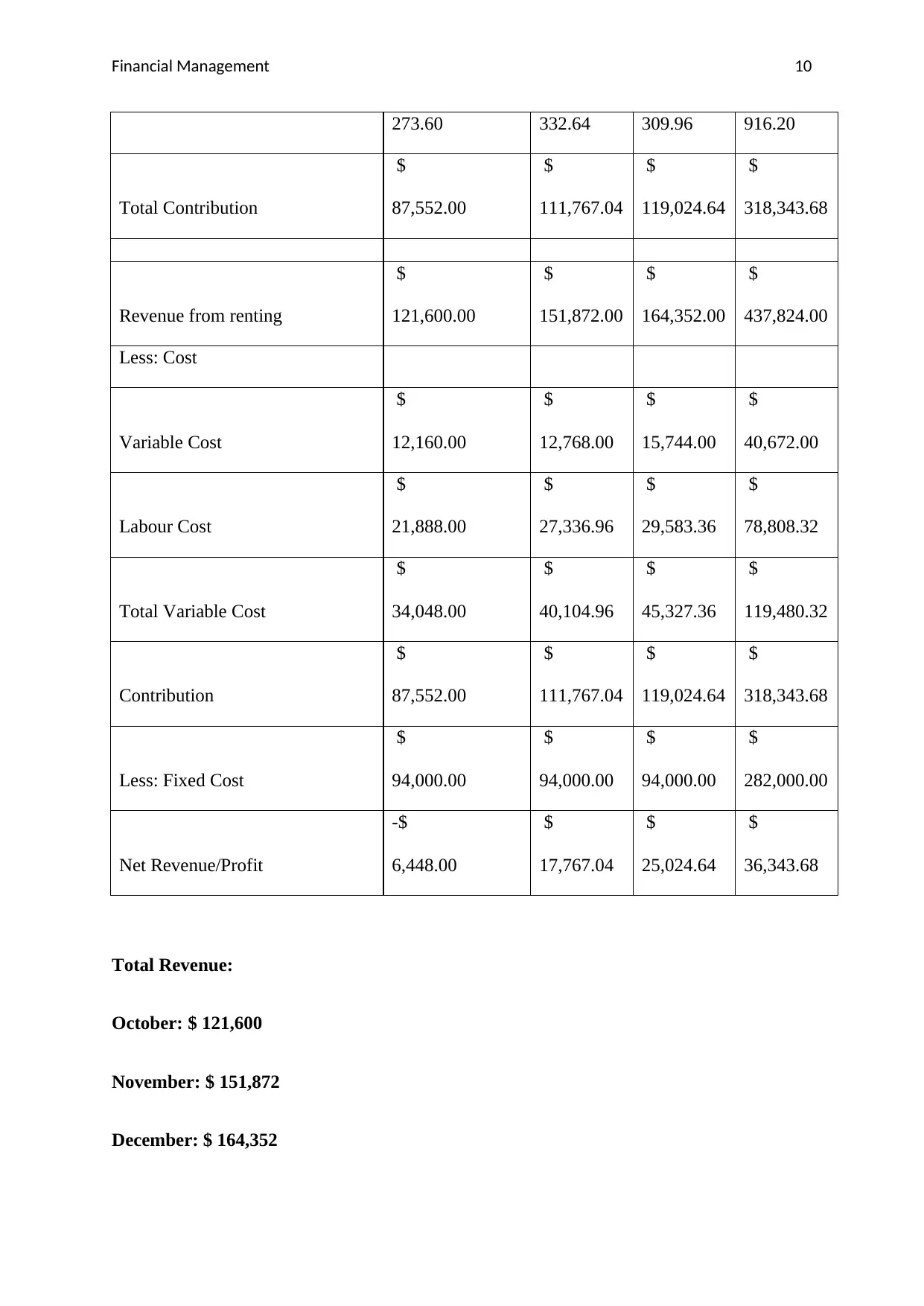
Financial Management 10
273.60 332.64 309.96 916.20
Total Contribution
$
87,552.00
$
111,767.04
$
119,024.64
$
318,343.68
Revenue from renting
$
121,600.00
$
151,872.00
$
164,352.00
$
437,824.00
Less: Cost
Variable Cost
$
12,160.00
$
12,768.00
$
15,744.00
$
40,672.00
Labour Cost
$
21,888.00
$
27,336.96
$
29,583.36
$
78,808.32
Total Variable Cost
$
34,048.00
$
40,104.96
$
45,327.36
$
119,480.32
Contribution
$
87,552.00
$
111,767.04
$
119,024.64
$
318,343.68
Less: Fixed Cost
$
94,000.00
$
94,000.00
$
94,000.00
$
282,000.00
Net Revenue/Profit
-$
6,448.00
$
17,767.04
$
25,024.64
$
36,343.68
Total Revenue:
October: $ 121,600
November: $ 151,872
December: $ 164,352
273.60 332.64 309.96 916.20
Total Contribution
$
87,552.00
$
111,767.04
$
119,024.64
$
318,343.68
Revenue from renting
$
121,600.00
$
151,872.00
$
164,352.00
$
437,824.00
Less: Cost
Variable Cost
$
12,160.00
$
12,768.00
$
15,744.00
$
40,672.00
Labour Cost
$
21,888.00
$
27,336.96
$
29,583.36
$
78,808.32
Total Variable Cost
$
34,048.00
$
40,104.96
$
45,327.36
$
119,480.32
Contribution
$
87,552.00
$
111,767.04
$
119,024.64
$
318,343.68
Less: Fixed Cost
$
94,000.00
$
94,000.00
$
94,000.00
$
282,000.00
Net Revenue/Profit
-$
6,448.00
$
17,767.04
$
25,024.64
$
36,343.68
Total Revenue:
October: $ 121,600
November: $ 151,872
December: $ 164,352
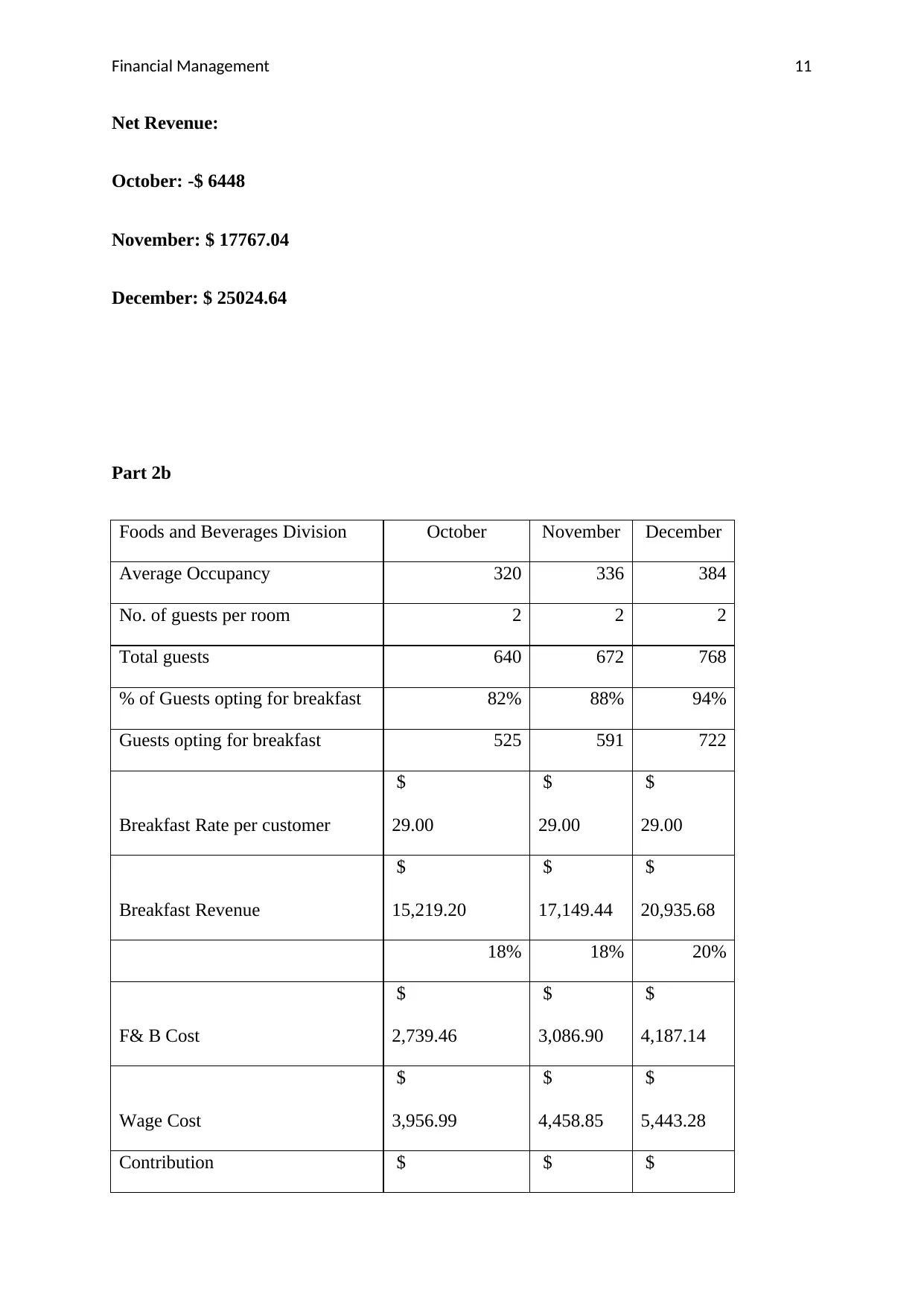
Financial Management 11
Net Revenue:
October: -$ 6448
November: $ 17767.04
December: $ 25024.64
Part 2b
Foods and Beverages Division October November December
Average Occupancy 320 336 384
No. of guests per room 2 2 2
Total guests 640 672 768
% of Guests opting for breakfast 82% 88% 94%
Guests opting for breakfast 525 591 722
Breakfast Rate per customer
$
29.00
$
29.00
$
29.00
Breakfast Revenue
$
15,219.20
$
17,149.44
$
20,935.68
18% 18% 20%
F& B Cost
$
2,739.46
$
3,086.90
$
4,187.14
Wage Cost
$
3,956.99
$
4,458.85
$
5,443.28
Contribution $ $ $
Net Revenue:
October: -$ 6448
November: $ 17767.04
December: $ 25024.64
Part 2b
Foods and Beverages Division October November December
Average Occupancy 320 336 384
No. of guests per room 2 2 2
Total guests 640 672 768
% of Guests opting for breakfast 82% 88% 94%
Guests opting for breakfast 525 591 722
Breakfast Rate per customer
$
29.00
$
29.00
$
29.00
Breakfast Revenue
$
15,219.20
$
17,149.44
$
20,935.68
18% 18% 20%
F& B Cost
$
2,739.46
$
3,086.90
$
4,187.14
Wage Cost
$
3,956.99
$
4,458.85
$
5,443.28
Contribution $ $ $
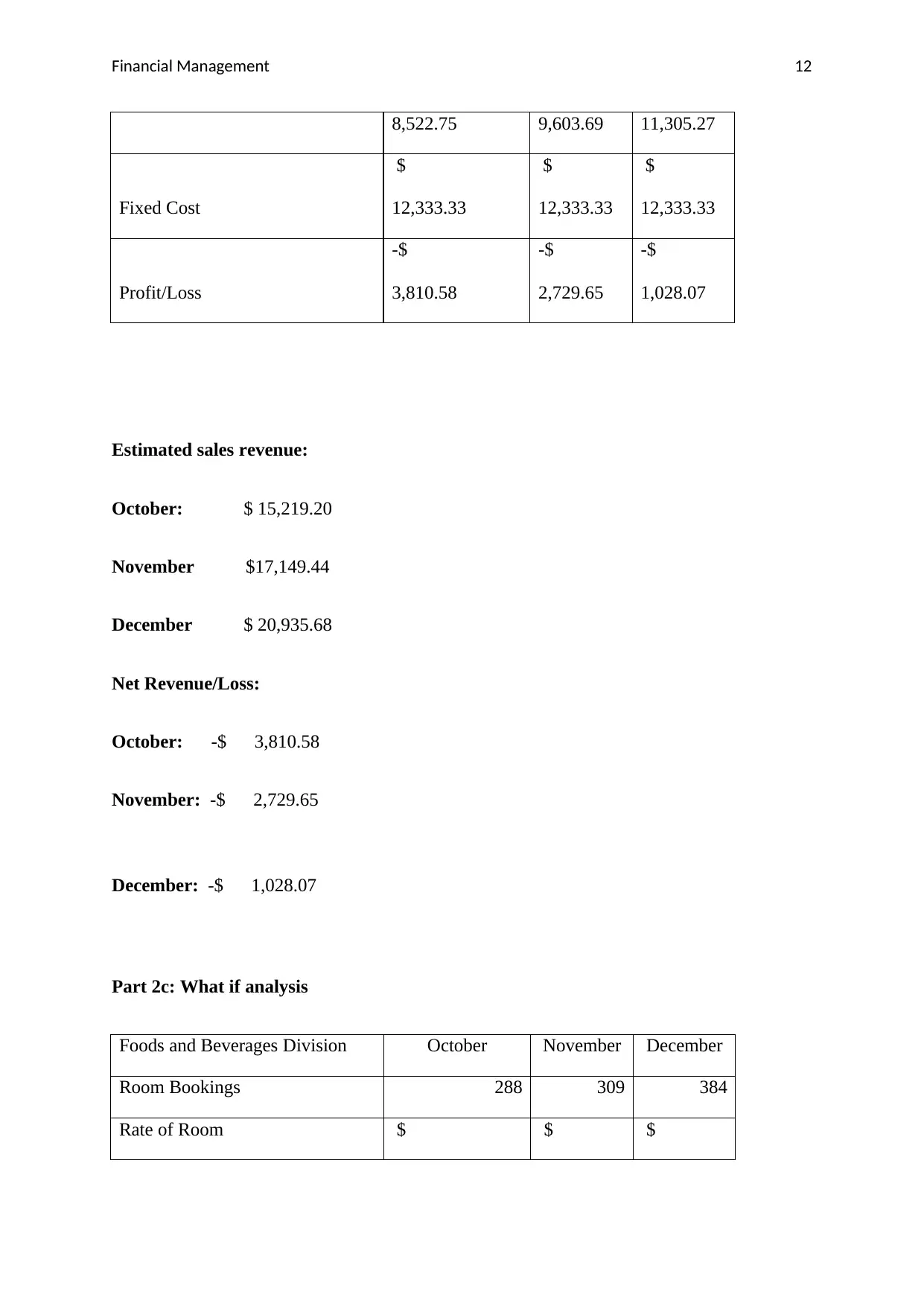
Financial Management 12
8,522.75 9,603.69 11,305.27
Fixed Cost
$
12,333.33
$
12,333.33
$
12,333.33
Profit/Loss
-$
3,810.58
-$
2,729.65
-$
1,028.07
Estimated sales revenue:
October: $ 15,219.20
November $17,149.44
December $ 20,935.68
Net Revenue/Loss:
October: -$ 3,810.58
November: -$ 2,729.65
December: -$ 1,028.07
Part 2c: What if analysis
Foods and Beverages Division October November December
Room Bookings 288 309 384
Rate of Room $ $ $
8,522.75 9,603.69 11,305.27
Fixed Cost
$
12,333.33
$
12,333.33
$
12,333.33
Profit/Loss
-$
3,810.58
-$
2,729.65
-$
1,028.07
Estimated sales revenue:
October: $ 15,219.20
November $17,149.44
December $ 20,935.68
Net Revenue/Loss:
October: -$ 3,810.58
November: -$ 2,729.65
December: -$ 1,028.07
Part 2c: What if analysis
Foods and Beverages Division October November December
Room Bookings 288 309 384
Rate of Room $ $ $
Paraphrase This Document
Need a fresh take? Get an instant paraphrase of this document with our AI Paraphraser

Financial Management 13
380.00 452.00 428.00
Room Revenue
$
109,440.00
$
139,722.24
$
164,352.00
Variable cost housekeeping
division
$
12,800.00
$
13,440.00
$
16,512.00
Variable cost F&B
$
2,821.64
$
3,179.51
$
4,312.75
Fixed Cost
Room Divisions
$
95,880.00
$
95,880.00
$
95,880.00
F&B Divisions
$
12,580.00
$
12,580.00
$
12,580.00
Changes in the overall profitability
October November December Total
Room
Revenue
$
109,440.00
$
139,722.24
$
164,352.00
$
413,514.24
F&B
Revenue
$
15,219.20
$
17,149.44
$
20,935.68
$
53,304.32
Total
$
124,659.20
$
156,871.68
$
185,287.68
$
466,818.56
380.00 452.00 428.00
Room Revenue
$
109,440.00
$
139,722.24
$
164,352.00
Variable cost housekeeping
division
$
12,800.00
$
13,440.00
$
16,512.00
Variable cost F&B
$
2,821.64
$
3,179.51
$
4,312.75
Fixed Cost
Room Divisions
$
95,880.00
$
95,880.00
$
95,880.00
F&B Divisions
$
12,580.00
$
12,580.00
$
12,580.00
Changes in the overall profitability
October November December Total
Room
Revenue
$
109,440.00
$
139,722.24
$
164,352.00
$
413,514.24
F&B
Revenue
$
15,219.20
$
17,149.44
$
20,935.68
$
53,304.32
Total
$
124,659.20
$
156,871.68
$
185,287.68
$
466,818.56

Financial Management 14
Variable
Cost
$
15,621.64
$
16,619.51
$
20,824.75
$
53,065.90
Wages
$
25,844.99
$
31,795.81
$
35,026.64
$
92,667.44
Contribution
$
83,192.57
$
108,456.36
$
129,436.29
$
321,085.22
Fixed Cost
$
108,460.00
$
108,460.00
$
108,460.00
$
325,380.00
Profit
-$
25,267.43
-$
3.64
$
20,976.29
-$
4,294.78
The what-if analysis has shown that the overall profitability of business of Zelma Hotel of $
36343.68 has turned down to the loss of $ -4294.78.
Part 2d)
If the number of room bookings are reduced by 10% in October and 8% in November and the
total fixed cost is increased by 2% for both room division as well as foods and beverage
division along with the increase in the variable cost of both housekeeping department and
food & beverage department, Zelma Hotel will have no profits after meeting all the costs and
expenses of the business. As the number of room bookings has reduced and the variable cost
as well as fixed cost has increased, the overall profitability of the business has declined. The
food and beverages department of Zelma Hotel is entailing losses in all the three months
under consideration as the revenue of this department is not sufficient to cover the costs and
expenses and hence it is entailing overall loses to the company. The hotel management must
bring out some schemes and offers to attract more customers so as to increase its revenue
Variable
Cost
$
15,621.64
$
16,619.51
$
20,824.75
$
53,065.90
Wages
$
25,844.99
$
31,795.81
$
35,026.64
$
92,667.44
Contribution
$
83,192.57
$
108,456.36
$
129,436.29
$
321,085.22
Fixed Cost
$
108,460.00
$
108,460.00
$
108,460.00
$
325,380.00
Profit
-$
25,267.43
-$
3.64
$
20,976.29
-$
4,294.78
The what-if analysis has shown that the overall profitability of business of Zelma Hotel of $
36343.68 has turned down to the loss of $ -4294.78.
Part 2d)
If the number of room bookings are reduced by 10% in October and 8% in November and the
total fixed cost is increased by 2% for both room division as well as foods and beverage
division along with the increase in the variable cost of both housekeeping department and
food & beverage department, Zelma Hotel will have no profits after meeting all the costs and
expenses of the business. As the number of room bookings has reduced and the variable cost
as well as fixed cost has increased, the overall profitability of the business has declined. The
food and beverages department of Zelma Hotel is entailing losses in all the three months
under consideration as the revenue of this department is not sufficient to cover the costs and
expenses and hence it is entailing overall loses to the company. The hotel management must
bring out some schemes and offers to attract more customers so as to increase its revenue
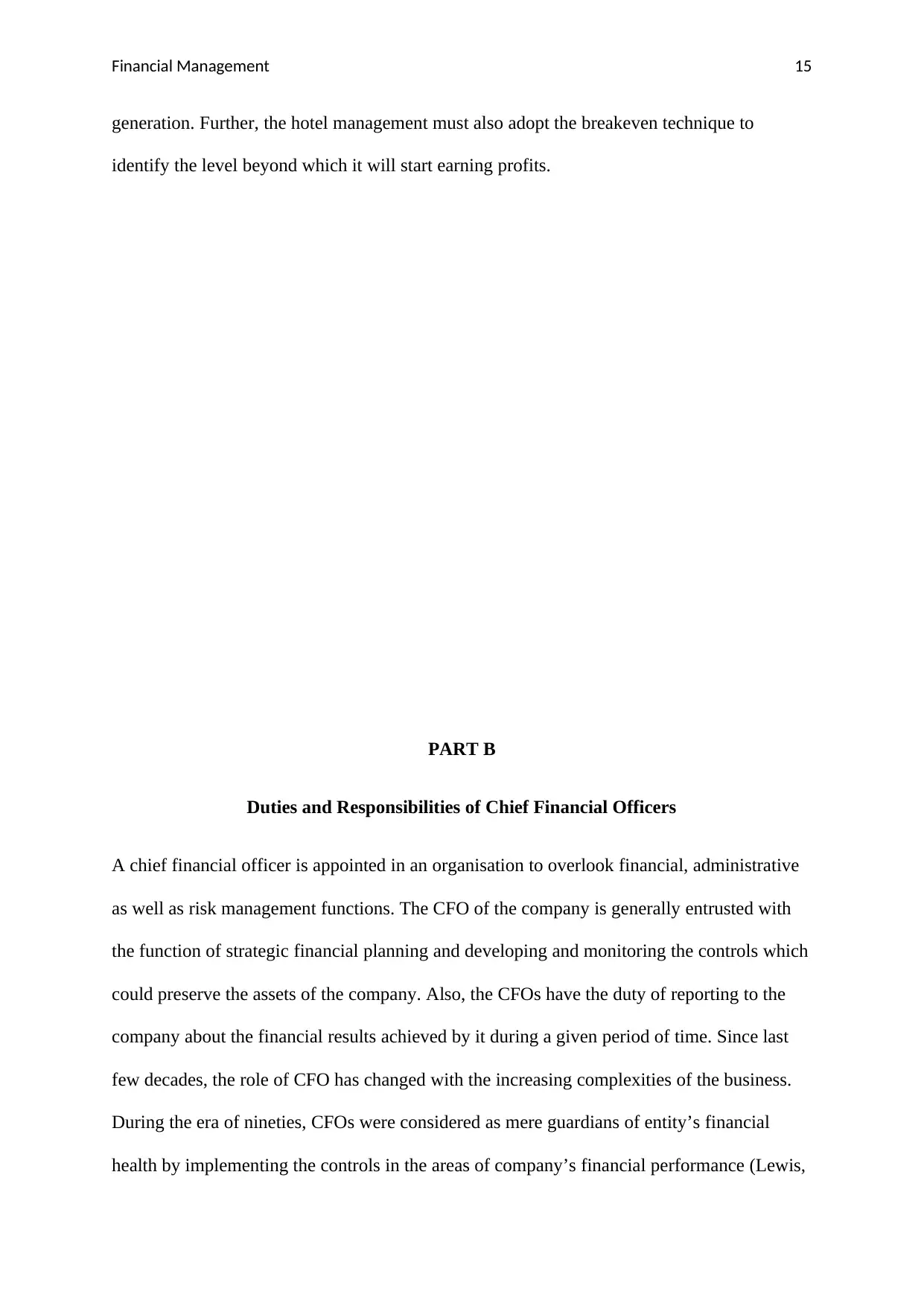
Financial Management 15
generation. Further, the hotel management must also adopt the breakeven technique to
identify the level beyond which it will start earning profits.
PART B
Duties and Responsibilities of Chief Financial Officers
A chief financial officer is appointed in an organisation to overlook financial, administrative
as well as risk management functions. The CFO of the company is generally entrusted with
the function of strategic financial planning and developing and monitoring the controls which
could preserve the assets of the company. Also, the CFOs have the duty of reporting to the
company about the financial results achieved by it during a given period of time. Since last
few decades, the role of CFO has changed with the increasing complexities of the business.
During the era of nineties, CFOs were considered as mere guardians of entity’s financial
health by implementing the controls in the areas of company’s financial performance (Lewis,
generation. Further, the hotel management must also adopt the breakeven technique to
identify the level beyond which it will start earning profits.
PART B
Duties and Responsibilities of Chief Financial Officers
A chief financial officer is appointed in an organisation to overlook financial, administrative
as well as risk management functions. The CFO of the company is generally entrusted with
the function of strategic financial planning and developing and monitoring the controls which
could preserve the assets of the company. Also, the CFOs have the duty of reporting to the
company about the financial results achieved by it during a given period of time. Since last
few decades, the role of CFO has changed with the increasing complexities of the business.
During the era of nineties, CFOs were considered as mere guardians of entity’s financial
health by implementing the controls in the areas of company’s financial performance (Lewis,
Secure Best Marks with AI Grader
Need help grading? Try our AI Grader for instant feedback on your assignments.
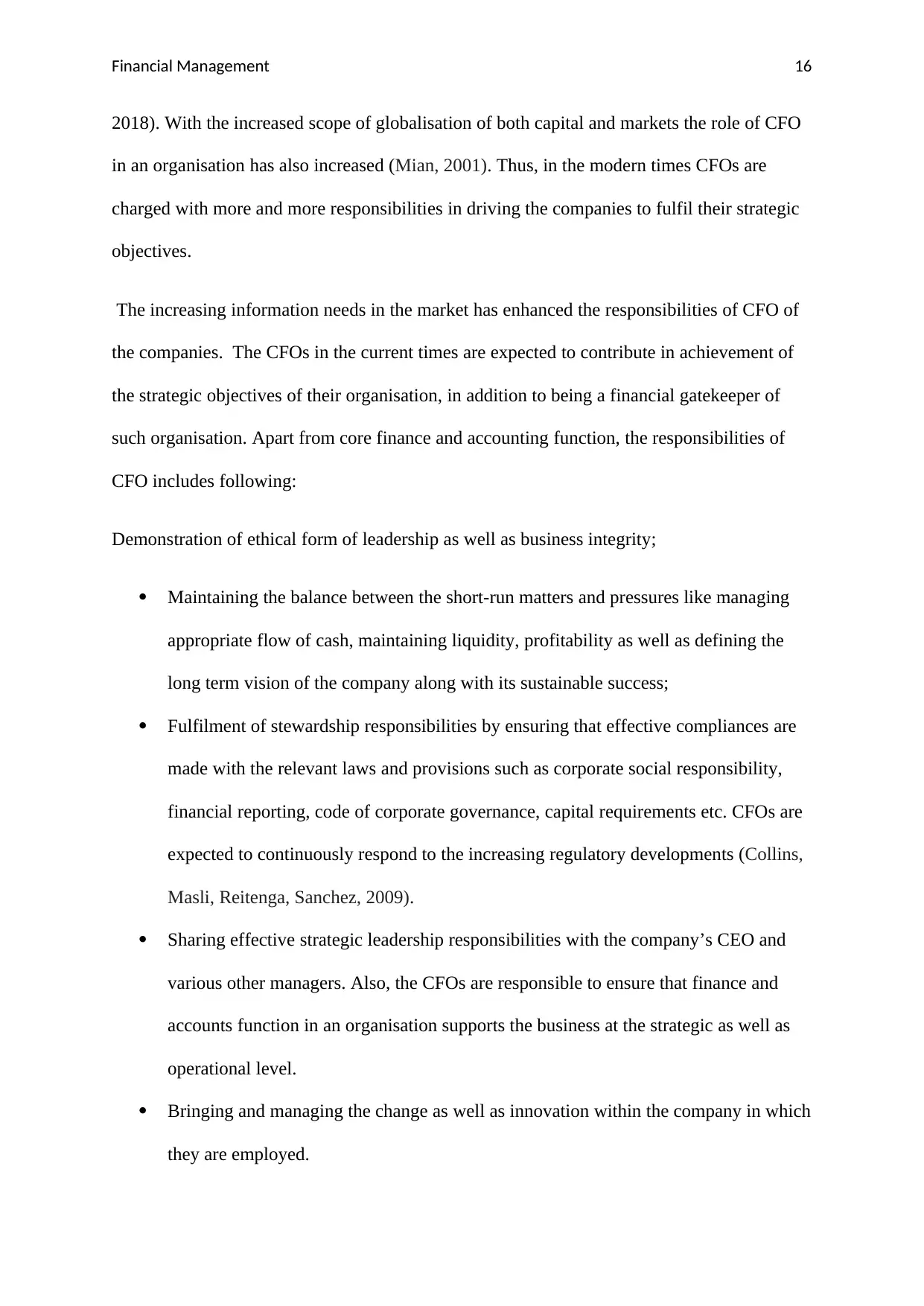
Financial Management 16
2018). With the increased scope of globalisation of both capital and markets the role of CFO
in an organisation has also increased (Mian, 2001). Thus, in the modern times CFOs are
charged with more and more responsibilities in driving the companies to fulfil their strategic
objectives.
The increasing information needs in the market has enhanced the responsibilities of CFO of
the companies. The CFOs in the current times are expected to contribute in achievement of
the strategic objectives of their organisation, in addition to being a financial gatekeeper of
such organisation. Apart from core finance and accounting function, the responsibilities of
CFO includes following:
Demonstration of ethical form of leadership as well as business integrity;
Maintaining the balance between the short-run matters and pressures like managing
appropriate flow of cash, maintaining liquidity, profitability as well as defining the
long term vision of the company along with its sustainable success;
Fulfilment of stewardship responsibilities by ensuring that effective compliances are
made with the relevant laws and provisions such as corporate social responsibility,
financial reporting, code of corporate governance, capital requirements etc. CFOs are
expected to continuously respond to the increasing regulatory developments (Collins,
Masli, Reitenga, Sanchez, 2009).
Sharing effective strategic leadership responsibilities with the company’s CEO and
various other managers. Also, the CFOs are responsible to ensure that finance and
accounts function in an organisation supports the business at the strategic as well as
operational level.
Bringing and managing the change as well as innovation within the company in which
they are employed.
2018). With the increased scope of globalisation of both capital and markets the role of CFO
in an organisation has also increased (Mian, 2001). Thus, in the modern times CFOs are
charged with more and more responsibilities in driving the companies to fulfil their strategic
objectives.
The increasing information needs in the market has enhanced the responsibilities of CFO of
the companies. The CFOs in the current times are expected to contribute in achievement of
the strategic objectives of their organisation, in addition to being a financial gatekeeper of
such organisation. Apart from core finance and accounting function, the responsibilities of
CFO includes following:
Demonstration of ethical form of leadership as well as business integrity;
Maintaining the balance between the short-run matters and pressures like managing
appropriate flow of cash, maintaining liquidity, profitability as well as defining the
long term vision of the company along with its sustainable success;
Fulfilment of stewardship responsibilities by ensuring that effective compliances are
made with the relevant laws and provisions such as corporate social responsibility,
financial reporting, code of corporate governance, capital requirements etc. CFOs are
expected to continuously respond to the increasing regulatory developments (Collins,
Masli, Reitenga, Sanchez, 2009).
Sharing effective strategic leadership responsibilities with the company’s CEO and
various other managers. Also, the CFOs are responsible to ensure that finance and
accounts function in an organisation supports the business at the strategic as well as
operational level.
Bringing and managing the change as well as innovation within the company in which
they are employed.

Financial Management 17
Engaging and continuously communicating with their colleagues and with the
stakeholders of company such as investors, customers, suppliers, governmental
agencies and so on (IFAC, 2013).
The stewardship responsibilities of CFOs have become more complex nowadays, particularly
in the areas of accounting, taxation and treasury management, regulatory and legal
compliances of different jurisdictions. Further, they have large roles to be played in the
corporate governance of the company as they have to work as the executive support for the
board of directors in their decision making process. Furthermore, they often have to support
the CEOs of the companies (Gore, Matsunaga & Eric Yeung, 2011). A CFO of the company
can also be its director with various statutory and fiduciary duties. Their duties as CFO are
extended to whole of the organisation which employs them. Hence, they must be aware of
their legal or fiduciary duties at the time of undertaking such processes which are aimed at
providing support to the board of directors as well as other members of management
understanding and taking the responsibility towards the fulfilment of their duties towards the
stakeholders of the company.
Moreover, the CFOs of the company must bring their professional qualities to their
responsibilities and they must also encourage the ethical behaviour as well as decision
making across the organisation so as to ensure that sustainable value creation is achieved in
their organisation (IFAC, 2013). They must strictly adhere to the basic principles of ethical
conduct while performing their responsibilities. These principles are: integrity, objectivity,
professional care and diligence, professional behaviour and confidentiality. CFOs have the
direct responsibility of ensuring that their employing organisation is attuned to strong ethical
standards which are aligned with its goals and objectives. They have to encourage
professionalism and the ethical behaviour throughout the organisation. As per the integrity
principle CFOs must remain straight-forward and honest while providing their professional
Engaging and continuously communicating with their colleagues and with the
stakeholders of company such as investors, customers, suppliers, governmental
agencies and so on (IFAC, 2013).
The stewardship responsibilities of CFOs have become more complex nowadays, particularly
in the areas of accounting, taxation and treasury management, regulatory and legal
compliances of different jurisdictions. Further, they have large roles to be played in the
corporate governance of the company as they have to work as the executive support for the
board of directors in their decision making process. Furthermore, they often have to support
the CEOs of the companies (Gore, Matsunaga & Eric Yeung, 2011). A CFO of the company
can also be its director with various statutory and fiduciary duties. Their duties as CFO are
extended to whole of the organisation which employs them. Hence, they must be aware of
their legal or fiduciary duties at the time of undertaking such processes which are aimed at
providing support to the board of directors as well as other members of management
understanding and taking the responsibility towards the fulfilment of their duties towards the
stakeholders of the company.
Moreover, the CFOs of the company must bring their professional qualities to their
responsibilities and they must also encourage the ethical behaviour as well as decision
making across the organisation so as to ensure that sustainable value creation is achieved in
their organisation (IFAC, 2013). They must strictly adhere to the basic principles of ethical
conduct while performing their responsibilities. These principles are: integrity, objectivity,
professional care and diligence, professional behaviour and confidentiality. CFOs have the
direct responsibility of ensuring that their employing organisation is attuned to strong ethical
standards which are aligned with its goals and objectives. They have to encourage
professionalism and the ethical behaviour throughout the organisation. As per the integrity
principle CFOs must remain straight-forward and honest while providing their professional
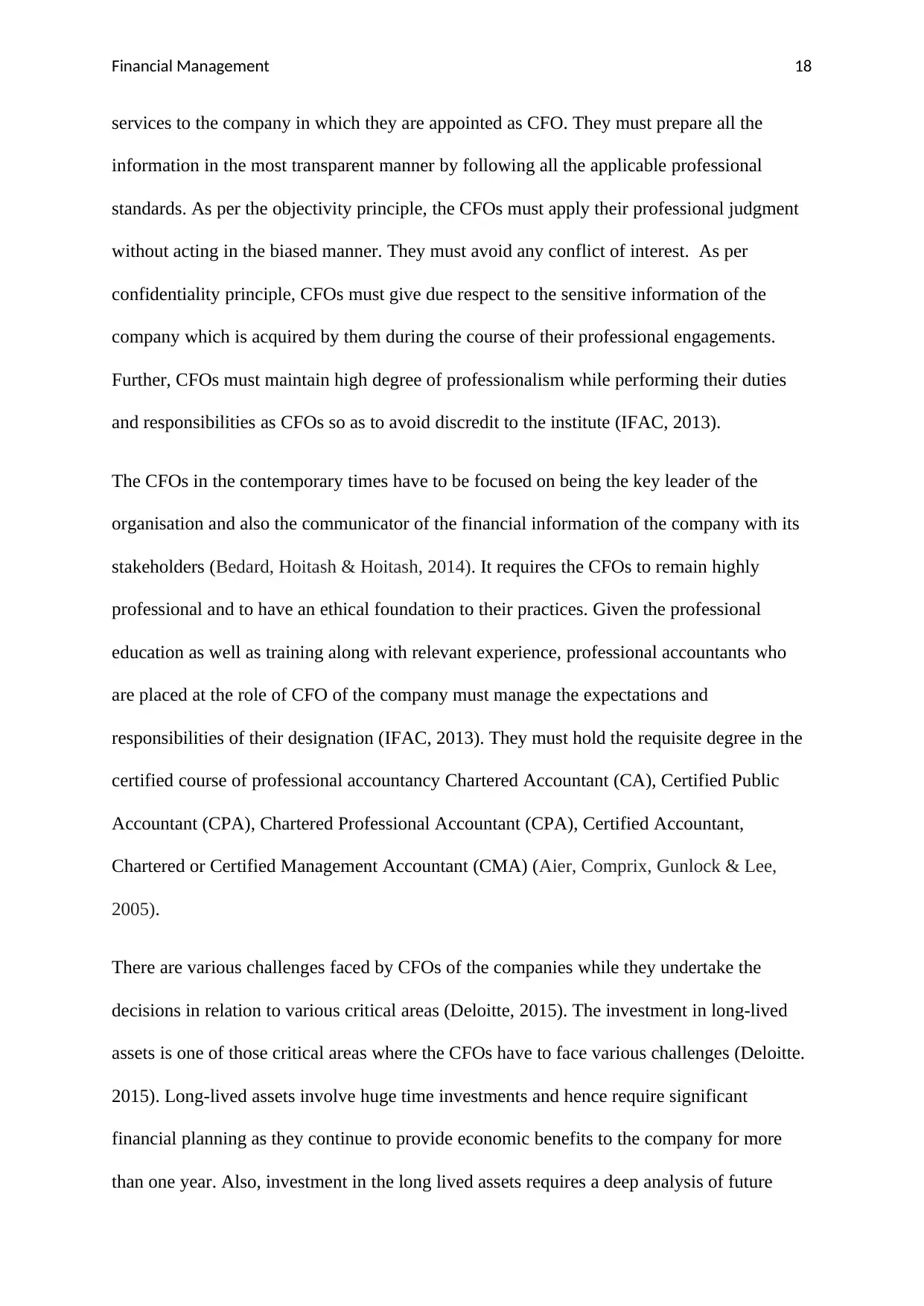
Financial Management 18
services to the company in which they are appointed as CFO. They must prepare all the
information in the most transparent manner by following all the applicable professional
standards. As per the objectivity principle, the CFOs must apply their professional judgment
without acting in the biased manner. They must avoid any conflict of interest. As per
confidentiality principle, CFOs must give due respect to the sensitive information of the
company which is acquired by them during the course of their professional engagements.
Further, CFOs must maintain high degree of professionalism while performing their duties
and responsibilities as CFOs so as to avoid discredit to the institute (IFAC, 2013).
The CFOs in the contemporary times have to be focused on being the key leader of the
organisation and also the communicator of the financial information of the company with its
stakeholders (Bedard, Hoitash & Hoitash, 2014). It requires the CFOs to remain highly
professional and to have an ethical foundation to their practices. Given the professional
education as well as training along with relevant experience, professional accountants who
are placed at the role of CFO of the company must manage the expectations and
responsibilities of their designation (IFAC, 2013). They must hold the requisite degree in the
certified course of professional accountancy Chartered Accountant (CA), Certified Public
Accountant (CPA), Chartered Professional Accountant (CPA), Certified Accountant,
Chartered or Certified Management Accountant (CMA) (Aier, Comprix, Gunlock & Lee,
2005).
There are various challenges faced by CFOs of the companies while they undertake the
decisions in relation to various critical areas (Deloitte, 2015). The investment in long-lived
assets is one of those critical areas where the CFOs have to face various challenges (Deloitte.
2015). Long-lived assets involve huge time investments and hence require significant
financial planning as they continue to provide economic benefits to the company for more
than one year. Also, investment in the long lived assets requires a deep analysis of future
services to the company in which they are appointed as CFO. They must prepare all the
information in the most transparent manner by following all the applicable professional
standards. As per the objectivity principle, the CFOs must apply their professional judgment
without acting in the biased manner. They must avoid any conflict of interest. As per
confidentiality principle, CFOs must give due respect to the sensitive information of the
company which is acquired by them during the course of their professional engagements.
Further, CFOs must maintain high degree of professionalism while performing their duties
and responsibilities as CFOs so as to avoid discredit to the institute (IFAC, 2013).
The CFOs in the contemporary times have to be focused on being the key leader of the
organisation and also the communicator of the financial information of the company with its
stakeholders (Bedard, Hoitash & Hoitash, 2014). It requires the CFOs to remain highly
professional and to have an ethical foundation to their practices. Given the professional
education as well as training along with relevant experience, professional accountants who
are placed at the role of CFO of the company must manage the expectations and
responsibilities of their designation (IFAC, 2013). They must hold the requisite degree in the
certified course of professional accountancy Chartered Accountant (CA), Certified Public
Accountant (CPA), Chartered Professional Accountant (CPA), Certified Accountant,
Chartered or Certified Management Accountant (CMA) (Aier, Comprix, Gunlock & Lee,
2005).
There are various challenges faced by CFOs of the companies while they undertake the
decisions in relation to various critical areas (Deloitte, 2015). The investment in long-lived
assets is one of those critical areas where the CFOs have to face various challenges (Deloitte.
2015). Long-lived assets involve huge time investments and hence require significant
financial planning as they continue to provide economic benefits to the company for more
than one year. Also, investment in the long lived assets requires a deep analysis of future
Paraphrase This Document
Need a fresh take? Get an instant paraphrase of this document with our AI Paraphraser
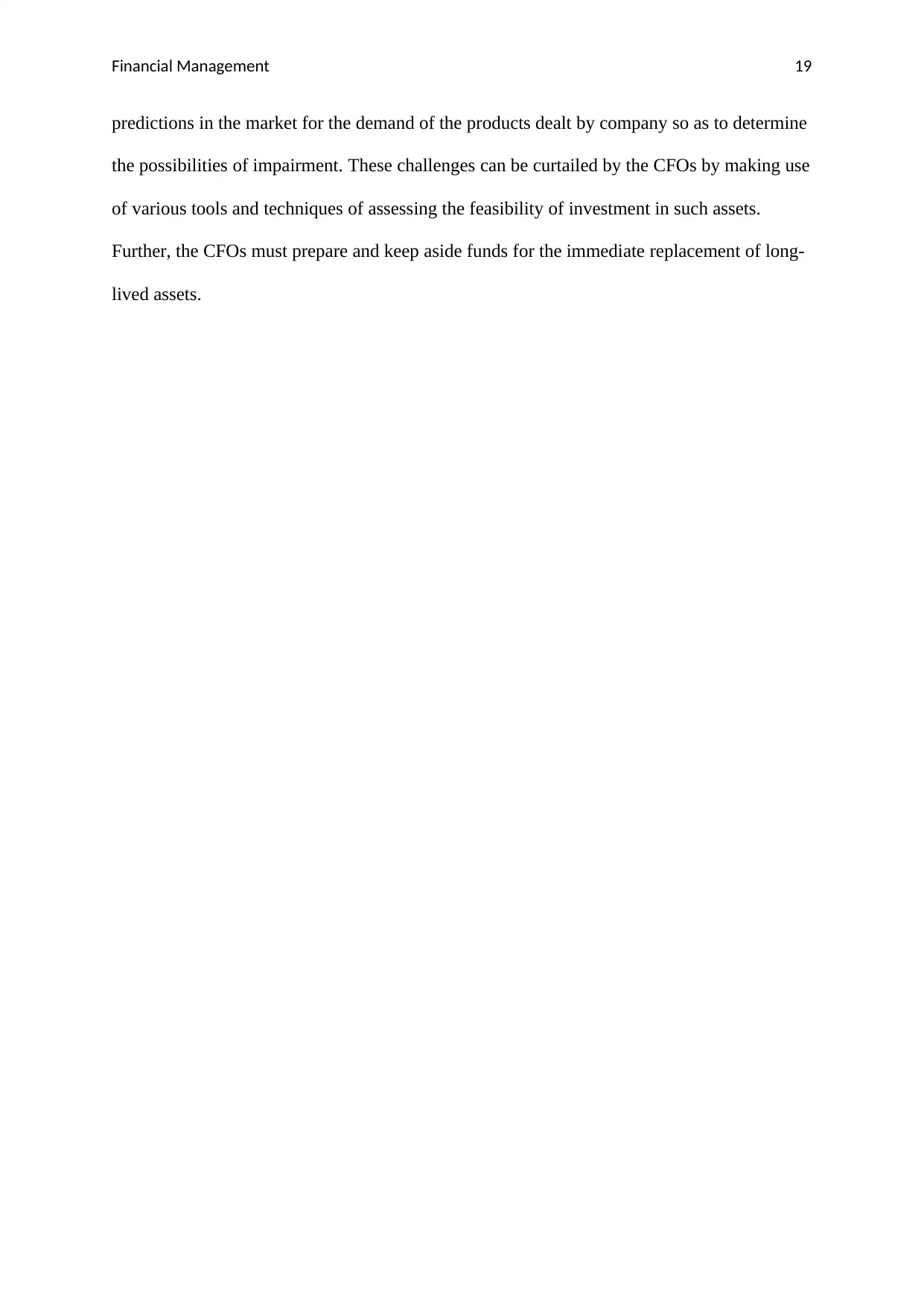
Financial Management 19
predictions in the market for the demand of the products dealt by company so as to determine
the possibilities of impairment. These challenges can be curtailed by the CFOs by making use
of various tools and techniques of assessing the feasibility of investment in such assets.
Further, the CFOs must prepare and keep aside funds for the immediate replacement of long-
lived assets.
predictions in the market for the demand of the products dealt by company so as to determine
the possibilities of impairment. These challenges can be curtailed by the CFOs by making use
of various tools and techniques of assessing the feasibility of investment in such assets.
Further, the CFOs must prepare and keep aside funds for the immediate replacement of long-
lived assets.
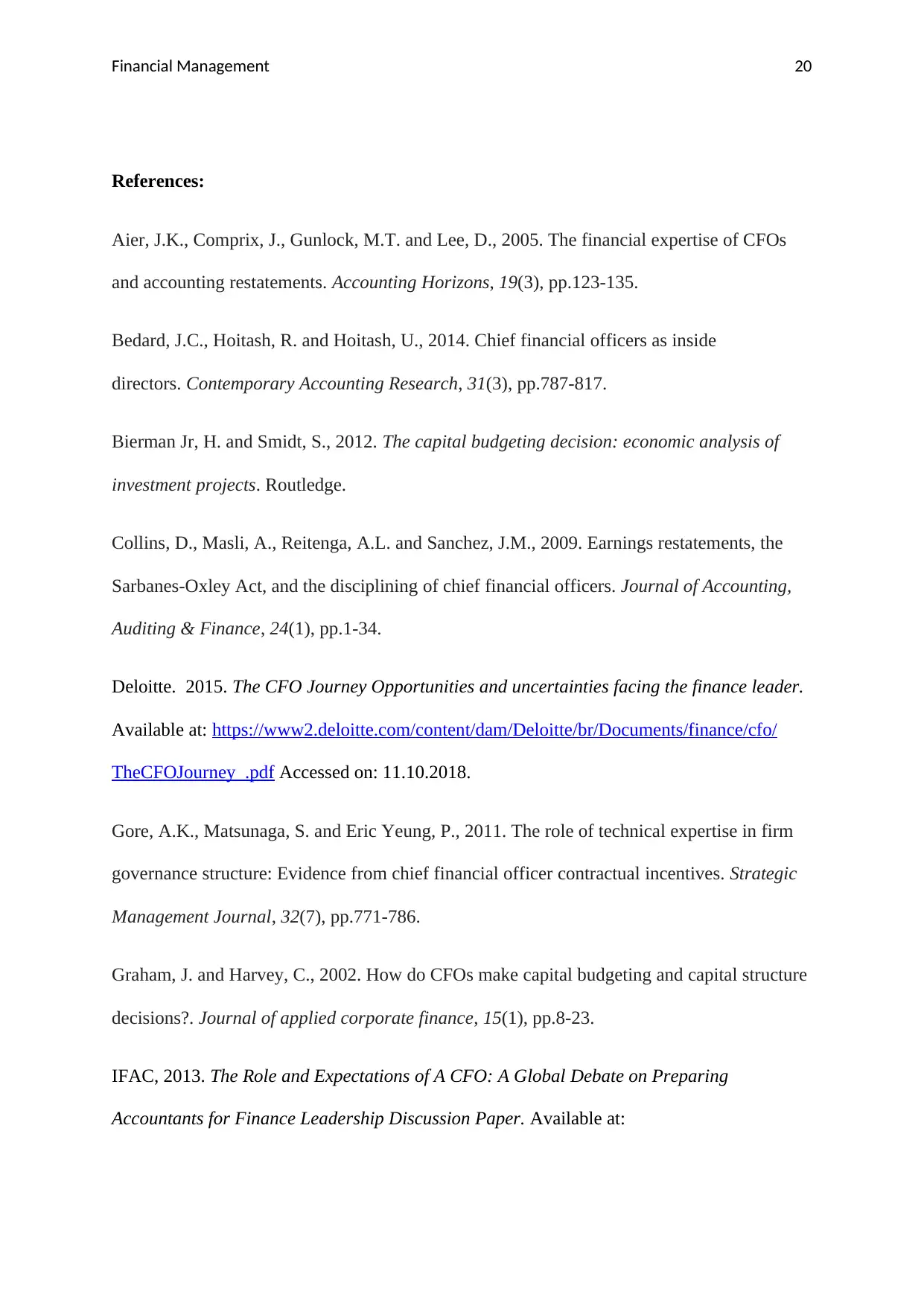
Financial Management 20
References:
Aier, J.K., Comprix, J., Gunlock, M.T. and Lee, D., 2005. The financial expertise of CFOs
and accounting restatements. Accounting Horizons, 19(3), pp.123-135.
Bedard, J.C., Hoitash, R. and Hoitash, U., 2014. Chief financial officers as inside
directors. Contemporary Accounting Research, 31(3), pp.787-817.
Bierman Jr, H. and Smidt, S., 2012. The capital budgeting decision: economic analysis of
investment projects. Routledge.
Collins, D., Masli, A., Reitenga, A.L. and Sanchez, J.M., 2009. Earnings restatements, the
Sarbanes-Oxley Act, and the disciplining of chief financial officers. Journal of Accounting,
Auditing & Finance, 24(1), pp.1-34.
Deloitte. 2015. The CFO Journey Opportunities and uncertainties facing the finance leader.
Available at: https://www2.deloitte.com/content/dam/Deloitte/br/Documents/finance/cfo/
TheCFOJourney_.pdf Accessed on: 11.10.2018.
Gore, A.K., Matsunaga, S. and Eric Yeung, P., 2011. The role of technical expertise in firm
governance structure: Evidence from chief financial officer contractual incentives. Strategic
Management Journal, 32(7), pp.771-786.
Graham, J. and Harvey, C., 2002. How do CFOs make capital budgeting and capital structure
decisions?. Journal of applied corporate finance, 15(1), pp.8-23.
IFAC, 2013. The Role and Expectations of A CFO: A Global Debate on Preparing
Accountants for Finance Leadership Discussion Paper. Available at:
References:
Aier, J.K., Comprix, J., Gunlock, M.T. and Lee, D., 2005. The financial expertise of CFOs
and accounting restatements. Accounting Horizons, 19(3), pp.123-135.
Bedard, J.C., Hoitash, R. and Hoitash, U., 2014. Chief financial officers as inside
directors. Contemporary Accounting Research, 31(3), pp.787-817.
Bierman Jr, H. and Smidt, S., 2012. The capital budgeting decision: economic analysis of
investment projects. Routledge.
Collins, D., Masli, A., Reitenga, A.L. and Sanchez, J.M., 2009. Earnings restatements, the
Sarbanes-Oxley Act, and the disciplining of chief financial officers. Journal of Accounting,
Auditing & Finance, 24(1), pp.1-34.
Deloitte. 2015. The CFO Journey Opportunities and uncertainties facing the finance leader.
Available at: https://www2.deloitte.com/content/dam/Deloitte/br/Documents/finance/cfo/
TheCFOJourney_.pdf Accessed on: 11.10.2018.
Gore, A.K., Matsunaga, S. and Eric Yeung, P., 2011. The role of technical expertise in firm
governance structure: Evidence from chief financial officer contractual incentives. Strategic
Management Journal, 32(7), pp.771-786.
Graham, J. and Harvey, C., 2002. How do CFOs make capital budgeting and capital structure
decisions?. Journal of applied corporate finance, 15(1), pp.8-23.
IFAC, 2013. The Role and Expectations of A CFO: A Global Debate on Preparing
Accountants for Finance Leadership Discussion Paper. Available at:
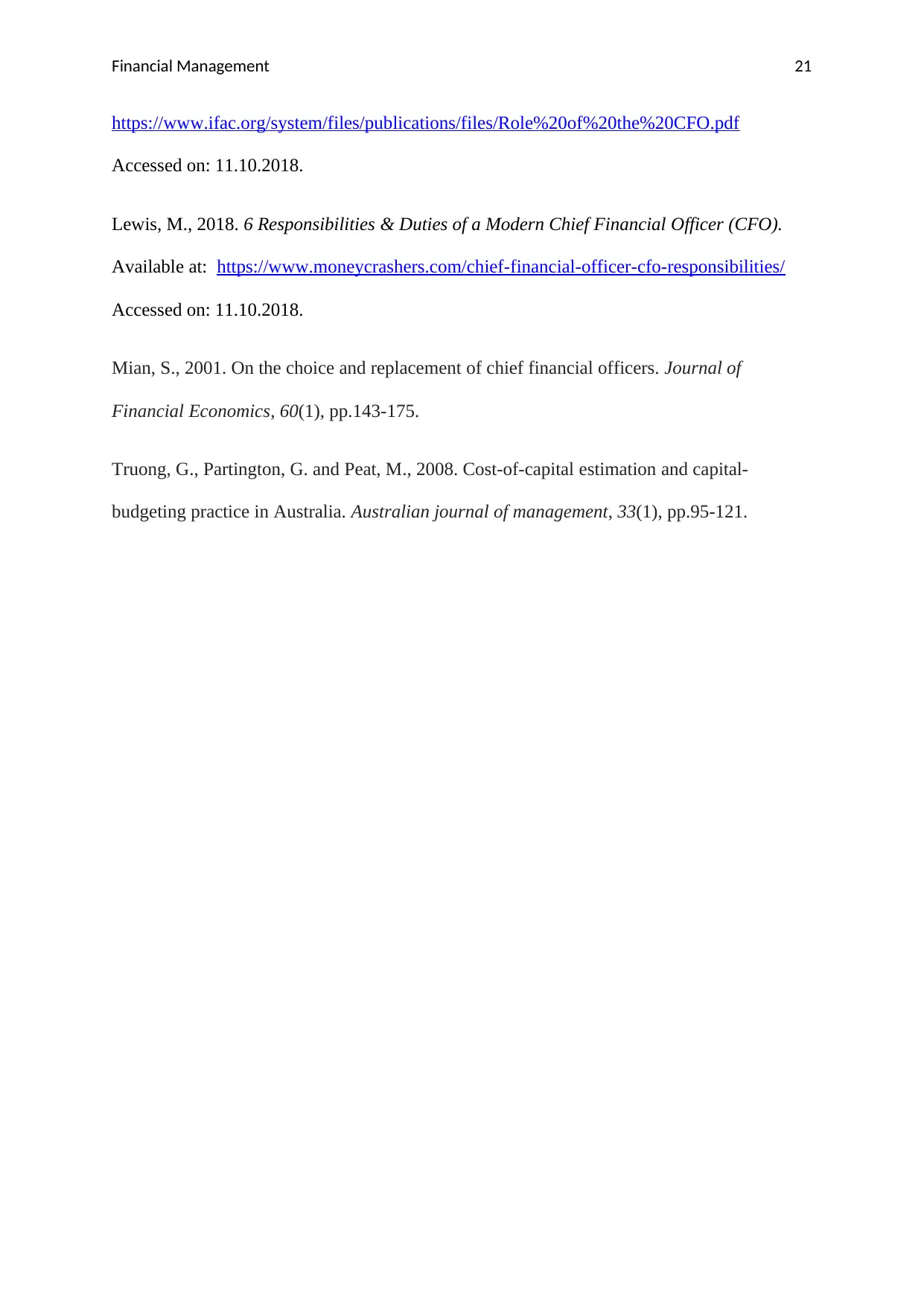
Financial Management 21
https://www.ifac.org/system/files/publications/files/Role%20of%20the%20CFO.pdf
Accessed on: 11.10.2018.
Lewis, M., 2018. 6 Responsibilities & Duties of a Modern Chief Financial Officer (CFO).
Available at: https://www.moneycrashers.com/chief-financial-officer-cfo-responsibilities/
Accessed on: 11.10.2018.
Mian, S., 2001. On the choice and replacement of chief financial officers. Journal of
Financial Economics, 60(1), pp.143-175.
Truong, G., Partington, G. and Peat, M., 2008. Cost-of-capital estimation and capital-
budgeting practice in Australia. Australian journal of management, 33(1), pp.95-121.
https://www.ifac.org/system/files/publications/files/Role%20of%20the%20CFO.pdf
Accessed on: 11.10.2018.
Lewis, M., 2018. 6 Responsibilities & Duties of a Modern Chief Financial Officer (CFO).
Available at: https://www.moneycrashers.com/chief-financial-officer-cfo-responsibilities/
Accessed on: 11.10.2018.
Mian, S., 2001. On the choice and replacement of chief financial officers. Journal of
Financial Economics, 60(1), pp.143-175.
Truong, G., Partington, G. and Peat, M., 2008. Cost-of-capital estimation and capital-
budgeting practice in Australia. Australian journal of management, 33(1), pp.95-121.
1 out of 22
Related Documents
Your All-in-One AI-Powered Toolkit for Academic Success.
+13062052269
info@desklib.com
Available 24*7 on WhatsApp / Email
![[object Object]](/_next/static/media/star-bottom.7253800d.svg)
Unlock your academic potential
© 2024 | Zucol Services PVT LTD | All rights reserved.




